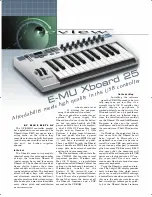
82
PF-500
You can select various scales.
Equal Temperament is the most common contem-
porary piano tuning scale. However, history has
known numerous other scales, many of which
serve as the basis for certain genres of music. You
can experience the tunings of these genres.
See the procedure on page 63.
Setting range:
Equal
One octave is divided into twelve equal
intervals. Currently most popular piano
tuning scale.
PureMajor/PureMinor
Based on natural overtones, three major
chords using these scales produce a beauti-
ful, pure sound. They are sometimes used
for chorus parts.
Pythagorean
This scale, designed by Pythagoras, a Greek
philosopher, is based on the interval of a
perfect 5th. The 3rd produces swells, but
the 4th and 5th are beautiful and suitable
for some leads.
MeanTone
This scale is an improvement of the
Pythagorean in that the swell of the 3rd has
been eliminated. It spread during the late
16th century through the late 18th century.
Handel used this scale.
WerckMeister/KirnBerger
These scales combine Mean Tone and
Pythagorean in different ways. With these
scales, modulation changes the impression
and feel of the songs. They were often used
in the era of Bach and Beethoven. They are
also often used now to reproduce the music
of that era on harpsichords.
Normal setting:
Equal
If you select a scale other than Equal, you need to
specify the root note using the B [–]/[+] buttons.
Setting range:
C, C
, D, E
, E, F, F
, G, A
, A, B
, B
You can specify the split point (the boundary between
the right-hand and left-hand keyboard areas).
See the procedure on page 63.
Setting range:
A-1–C7
You can also use [SPLIT] to set the split point. (page 33)
TRANSPOSE= To change the key
(Changing the key: To raise or lower the overall pitch of
the entire song.)
The PF-500’s Transpose function makes it possible to
shift the pitch of the entire keyboard up or down in semi-
tone intervals to facilitate playing in difficult key signa-
tures, and to let you easily match the pitch of the
keyboard to the range of a singer or other instruments.
For example, if you set the transposition amount to “5,”
playing key C produces pitch F. In this way, you can play
the song as if it were in C major, and the PF-500 will
transpose it to the key of F.
Setting for:
Master
The sound of the entire instrument
(the manually-played sound and the
song playback)
Keyboard
The manually-played sound
Song
The song playback
Selecting a scale [Scale]
C
A
D
B
NO
YES
Specifying the Split Point
[SplitPoint]
Changing the key [Transpose]
C
A
D
B
NO
YES
C
A
D
B
NO
YES
NOTE
TIP
Summary of Contents for PF-500
Page 17: ...PF 500 17 Basic Operation ...
Page 59: ...PF 500 59 Detailed Settings ...
Page 92: ...92 PF 500 MEMO ...
Page 93: ...PF 500 93 Appendix ...
Page 104: ...104 PF 500 MEMO ...
















































